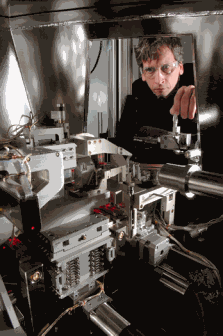The Hard X-ray Nanoprobe at the U.S. Department of Energy’s Advanced Photon Source (APS) at Argonne National Laboratory has received one of four R&D 100 awards presented to Argonne by R&D Magazine.
The Hard X-ray Nanoprobe provides materials characterization using x-ray diffraction, x-ray fluorescence, and transmission imaging at unprecedented spatial resolution in the hard x-ray range. Significant advances in high-accuracy positioning allow positioning of the x-ray optics and sample with an accuracy of two nanometers. This enables the use of advanced x-ray optics — stacked zone plates and multilayer Laue lenses — with a spatial resolution of 30 nanometers or below, providing an unmatched spatial resolution in the hard x-ray range. This has already provided users with a better understanding of strain in silicon-based devices, distribution of matrix elements in geopolymers, Resistive RAM systems, and novel nanocomplosites.
The nanoprobe will also significantly improve the ability of medical scientists and nanoscientists to study use of nanocomposites in tissues, cells and subscellular organelles, which helps develop new medical imaging techniques and therapies.
The Hard X-ray Nanoprobe is the first system to integrate x-ray fluorescence, x-ray diffraction, and full-field imaging exchangeable into a single instrument. This allows fast acquisition of full-field tomographic images combined with x-ray fluorescence and/or x-ray diffraction characterization in situ. The nanoprobe offers the combination of superior hard x-ray spatial resolution with very high elemental and strain sensitivity, and operation at atmospheric pressure or in a vacuum. It takes advantage of the properties of hard x-rays by allowing imaging of thick and optically opaque samples and the study of inner structures and buried interfaces, while being nonintrusive and nondestructive.
The Hard X-ray Nanoprobe was jointly developed by a team from Argonne and Xradia, Inc. The Argonne team consisted of Jörg Maser, physicist; Deming Shu, senior engineer; Robert Winarski, physicist; Martin Holt, assistant physicist; Brian Stephenson, senior physicist; and Volker Rose, assistant physicist. The Xradia, Inc. team consisted of Michael Feser, VP/GM X-ray Nano-Imaging; Tobias Beetz, project manager; Juana Rudati, project manager; and Wenbing Yun. President/CTO.
Over the course of 47 years, the R&D 100 Awards have become a symbol of technological innovation and excellence. In that time, Argonne researchers have earned 105 awards.
An article on all of Argonne’s 2009 R&D 100 winners can be read here.
The Advanced Photon Source at Argonne National Laboratory is supported by the U. S. Department of Energy, Office of Science, Office of Basic Energy Sciences under Contract No. DE-AC02-06CH11357.
Argonne National Laboratory seeks solutions to pressing national problems in science and technology. The nation's first national laboratory, Argonne conducts leading-edge basic and applied scientific research in virtually every scientific discipline. Argonne researchers work closely with researchers from hundreds of companies, universities, and federal, state and municipal agencies to help them solve their specific problems, advance America 's scientific leadership and prepare the nation for a better future. With employees from more than 60 nations, Argonne is managed by UChicago Argonne, LLC for the U.S. Department of Energy's Office of Science.

